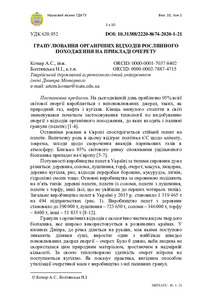Please use this identifier to cite or link to this item:
http://elar.tsatu.edu.ua/handle/123456789/10726Full metadata record
| DC Field | Value | Language |
|---|---|---|
| dc.contributor.author | Комар, Артем Станіславович | - |
| dc.contributor.author | Комар, Артем Станиславович | - |
| dc.contributor.author | Komar, Artem | - |
| dc.contributor.author | Болтянська, Наталя Іванівна | - |
| dc.contributor.author | Болтянская, Наталья Ивановна | - |
| dc.contributor.author | Boltianska, Natalia | - |
| dc.date.accessioned | 2020-05-19T10:08:38Z | - |
| dc.date.available | 2020-05-19T10:08:38Z | - |
| dc.date.issued | 2020 | - |
| dc.identifier.uri | http://elar.tsatu.edu.ua/handle/123456789/10726 | - |
| dc.description.abstract | UK: В статті показано можливість отримання палива із органічних відходів рослинного походження, а саме очерету у вигляді гранул в лабораторних умовах. Утилізація тростино-очеретяної маси дозволить знизити антропогенне навантаження на довкілля, за рахунок переведення її із категорії відходів у категорію – палива. Високий вміст лігніну в очереті є важливим, оскільки він виступає одночасно і в’яжучим та енергетичним компонентом. Органічна маса очерету є додатковим джерелом енергії та армуючим матеріалом гранульованого палива. Отримане за аналогією паливо характеризується теплотворною здатністю 18000 кДж/кг, зольністю близько 5-8 %, вологістю 6-10 % та насипною густиною 1,1–1,12 г/см3. RU: В статье показана возможность получения топлива из органических отходов растительного происхождения, а именно тростника в виде гранул в лабораторных условиях. Утилизация трость-тростниковой массы позволит снизить антропогенную нагрузку на окружающую среду, за счет перевода ее с категории отходов в категорию - топлива. Высокое содержание лигнина в камышах является важным, поскольку он выступает одновременно и вяжущим и энергетическим компонентом. Органическая масса тростника является дополнительным источником энергии и армирующими материалом гранулированного топлива. Полученное по аналогии топливо характеризуется теплотворной способностью 18000 кДж / кг, зольностью около 5-8%, влажностью 6-10% и насыпной плотностью 1,1-1,12 г / см3. EN: Today, approximately 95% of all global energy is produced from non-renewable sources, such as natural gas, oil and coal. The end of the last century in the world was marked by the beginning of the application of technology for the extraction of energy from waste of organic origin, which includes fuel granules. Pellet production capacities in Ukraine vary greatly by type of raw material: wood, straw, husk, peat, bulrush, oilcake, alfalfa, charcoal, rice, flour processing waste, corn, lignin, hydrolysis resins and the like. Determined that it is better for the production of pellets suitable such organic waste: wood chips, sawdust, shavings, straw, sunflower husks, bagasse, alfalfa, waste from the processing of flour, corn, lignin, cane etc. In the combustion process of pellets is too much ash and noxious gases, and emits 15 times less CO2 than burning natural gas. Besides, pellets are relatively inexpensive and low smoke emit enough heat. Found that all indicators of fuel pellets made from reed, absolutely not inferior to the peat, and pellets of pressed straw. Moreover, during the combustion of pellets from cane is less release of sulfur and carbon dioxide, which has a positive impact on the environment. This type of fuel of plant origin odourless, and can be used as a natural adsorbent. the main advantages of making fuel pellets from cane-sugar mass. The article shows the possibility of obtaining fuels from organic wastes of plant origin, namely cane in the form of granules in the laboratory. Utilization of cane mass will reduce the anthropogenic load on the environment, due to the transfer of her waste categories in the category of fuel. The high content of lignin in the reeds is important because it acts as both astringent and and energy component. Organic mass cane is an additional source of energy, and reinforcing material of pellet fuel. Received by analogy the fuel is characterized by a calorific value of 18,000 kJ / kg, ash content of about 5-8%, humidity of 6-10% and a bulk density of 1.1-1.12 g / cm3. | uk |
| dc.language.iso | uk | uk |
| dc.relation.ispartofseries | Науковий вісник ТДАТУ;Вип. 10, т. 1 | - |
| dc.subject | гранулювання | uk |
| dc.subject | відходи рослинного походження | uk |
| dc.subject | очерет | uk |
| dc.subject | пелети | uk |
| dc.subject | біопаливо | uk |
| dc.subject | гранулирование | uk |
| dc.subject | отходы растительного происхождения | uk |
| dc.subject | камыш | uk |
| dc.subject | пеллеты | uk |
| dc.subject | биотопливо | uk |
| dc.subject | granulation | uk |
| dc.subject | waste of vegetable origin | uk |
| dc.subject | reeds | uk |
| dc.subject | pellets | uk |
| dc.subject | biofuels | uk |
| dc.title | Гранулювання органічних відходів рослинного походження на прикладі очерету | uk |
| dc.title.alternative | Гранулирования органических отходов растительного происхождения на примере камыша | uk |
| dc.title.alternative | Granulation of waste of vegetable origin on example of reed | uk |
| dc.type | Article | uk |
| Appears in Collections: | Кафедра Експлуатації та технічного сервісу машин | |
Files in This Item:
| File | Description | Size | Format | |
|---|---|---|---|---|
| 21. Комар.pdf | 975.54 kB | Adobe PDF |  View/Open |
Show simple item record
CORE Recommender
???jsp.display-item.check???
Items in DSpace are protected by copyright, with all rights reserved, unless otherwise indicated.
